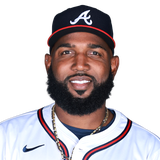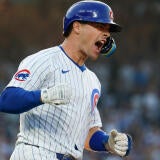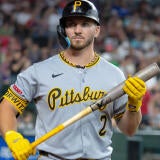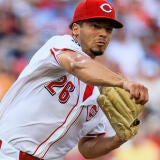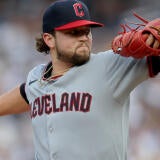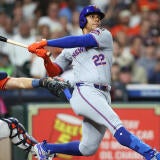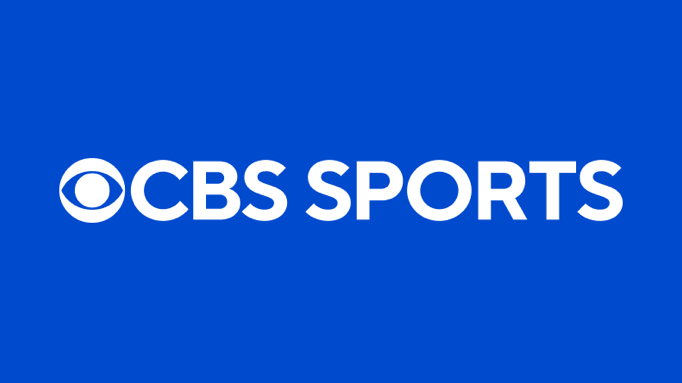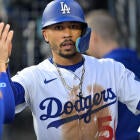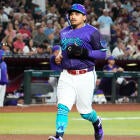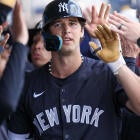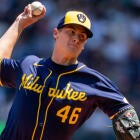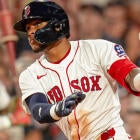Fantasy Baseball: Time to sort out which struggling studs to give up on and which to stand behind
The halfway point is a good time to acknowledge that not every early investment is going to come around

I use "give up on" in the headline because that's the sort of attention-grabbing phraseology required of a headline in this attention-starved media landscape, but I of course don't mean it literally.
What I am conceding is that we need to adjust our expectations for certain underachievers now that the season is halfway done. The term "slow start" would no longer seem to apply now that we're closer to the finish line than the starting line.
And yet it's still not too late for players, particularly those of a star pedigree, to turn their season around. Don't believe me? Just look at what these players were doing through June 30 of last year:
You may recognize them from the early rounds of this year's draft. Fair to say they righted the ship thereafter.
I could see the same happening for this first group of seven. I'm less convinced of the five that follow.
Keep the faith in these seven
| ||||||||||||
Plate discipline was never Michael Harris' strong suit, but with the amount he's chasing this year, he hasn't drawn a walk since May 18. Hitting coach Tim Hyers recently told Mark Bowman of MLB.com that it's just "the growing pains of a young player," and he has a point. Harris is indeed young at age 24, but he's also established, having delivered high-end numbers for three consecutive years. It would be hard to dismiss his success to this point as a fluke, in other words. Whatever he's going through now is the aberration, not the norm.
Of course, he also has to contend with the additional hurdle of lost playing time, having sat out against back-to-back lefties over the weekend, but apparently, that was just a ploy to "calm things down for him," in the words of manager Brian Snitker. Hyers remains confident that Harris "can turn things around in a heartbeat," and while you could dismiss that as cheery talk, it's kind of how things played out for him the previous two years. As late as June 8 last year, Harris was hitting .244 with a .641 OPS, and as late as June 6 two years ago, he was hitting .163 with a .490 OPS. Fair to say he turned things around on both of those occasions.
| ||||||||||||
A quick glance at Bryan Reynolds' Baseball Savant page would hardly give you the impression that he's having a career-worst season. All the major offense measurements are lit up in red while his .527 xSLG is a career high and his .287 xBA is close to it. So why do his actual numbers fall short of those theoretical ones? I wouldn't say it's all luck. His 25.3 percent strikeout rate is his highest since 2020, and his 14.4 percent pull air rate is the lowest of his career. I've noticed that when Statcase flags a hitter as an underachiever, it's typically one (or both) of those things that's not like the others. But both are as much a symptom as a cause. As long as he's impacting the ball as hard as usual, I'd worry less about diminished ability than technical glitches that can be smoothed over. It may already be happening given that he's 15 for 35 (.429) with two homers in his past eight games.
| ||||||||||||
You drafted Dylan Cease thinking you were getting an ace, but what you've actually gotten is a 4.53 ERA. It's frustrating, but it's within his established range of outcomes, as demonstrated by his 4.58 ERA in 2023. That doesn't mean I'm condemning him to the same fate as then. I'm simply noting the high degree of variance that exists in this game, particularly when working with partial-season samples and particularly for someone like Cease, whose self-inflicted wounds (his walks, in other words) only add to that variance by reducing the margin for error. Even so, no ERA estimator of any renown suggests he's come close to earning the 4.53 mark he currently has. Instead, they range from 3.23 to 3.51, with FIP being the lowest and xERA the highest. Cease's 3.47 ERA last year falls squarely within that range, and we've all already decided it's worth it for the kind of strikeout numbers he provides.
| ||||||||||||
Some might say that Austin Riley's numbers aren't bad enough for him to warrant a mention here, but seeing as someone recently asked me if he could drop Riley in a shallow 10-team league if he also had Max Muncy, I'd say that the 28-year-old's stock has taken a hit. By Head-to-Head points scoring (never Riley's best format, but true studs are good in all formats), Riley trails not only Muncy but also Miguel Vargas and Nolan Arenado.
A career-high 28.1 percent strikeout rate likely has something to do with that and will need to be remedied in some way, but at the same time, his .269 batting average and .746 OPS right now look don't look so different form his .250 batting average and .745 OPS at the end of June last year. He also had a .260 batting average and .748 OPS on June 18 two years ago and a .224 batting average and .744 OPS on May 22 three years ago. Those aren't all the same dates, of course, but they underscore the pattern of Riley doing his best work in the summer months. In July and August, he's a career .290 hitter with a .910 OPS. In all the other months, he's a career .263 hitter with a .793 OPS.
| ||||||||||||
You might argue it's too late for me to feature Corey Seager here given that he's 7 for 22 (.318) with three home runs in his past six games, but if that's all it takes to relieve your every concern over one of these struggling studs, it only bolsters the premise of this article, which is that what happened in the past three months has little say over what happens in the next three.
If the skills are fully intact, the numbers are likely to normalize, and all of Seager's Statcast data would suggest the skills are fully intact. His .289 xBA and .545 xSLG are both right about where they always are, and he's the ninth-biggest underachiever according to xwOBA. The only metric that's noticeably lagging is his pull air rate, which is the second-lowest of his career at 11.3 percent, but the only year that was lower, 2021, was among his best performance-wise. He's been tinkering with his stance in an effort to get that optimal spray angle back, and I'm confident he will (if he hasn't already).
| ||||||||||||
The Statcast scouts among us will denote the amount of blue on Adley Rutschman's Baseball Savant page as if it's something new, but in reality, there's next to nothing there that's any different from the rest of his career. Those modest exit velocities were enough to make him the No. 1 pick in the 2019 draft, a consensus top-five prospect for his three years in the minors, a Rookie of the Year runner-up in 2022, and an All-Star in the two years that followed. He was one of the most hyped catcher prospects we've ever had, and until very recently, he lived up to it. Even now, for all the blue on his Baseball Savant page, Statcast says he should be hitting .260 and slugging .453, making him one of the biggest underachievers in both categories. It'll be a couple weeks before he's able to contribute again because of an oblique strain, but for the amount of good he could do at a position that's often treated as a throwaway, you have to keep the faith.
| ||||||||||||
After a strong start to the season, Marcell Ozuna's performance has taken an ugly turn here in June, seeing his slugging percentage drop below .400. The easy (and perhaps correct) explanation is that he's playing through a tear in his hip that's likely to necessitate surgery after the season. So why am I still holding out hope? Because I'm not convinced that's what's actually going on here.
The hip injury first came to light on April 13. He returned to the lineup April 18 and had an .869 OPS over his next 31 games, homering six times in 137 plate appearances. His average exit velocity during that span was nearly 92 mph. If the hip was to blame, wouldn't the slip in production be more immediate? His exit velocities remain strong for the season as a whole, and his plate discipline is about the best it's ever been. The biggest issue I can see is that he's putting the ball on the ground more than usual, which should be a minor fix for an established veteran like him. What would change my mind is if the ground balls are a byproduct of something he has to do mechanically to maintain the hip, but I'm not ready to conclude that yet.
Adjust your expectations for these five
| ||||||||||||
I wish I could keep the faith in Ozzie Albies because he's been so reliable through age 27, delivering an OPS over .750 in every healthy season. What about the unhealthy seasons? I'm mostly talking about 2022 (.703 OPS) and 2024 (.707 OPS), when he missed significant time with some broken bone or another. Those two years have something else in common, though. They're the only ones over Albies' nine-year career in which the league-wide home run-to-fly ball rate was less than 12 percent.
The ball wasn't carrying as well, in other words, and that's likely to impact Albies more than other sluggers. See, for as many home runs as he's contributed, he doesn't actually hit the ball that hard, his average exit velocities generally ranking in the lower half, if not the lower third, of the league. The angle the ball takes off the bat can make up for that, but only if it's carrying like normal. And this year, like in 2022 and 2024, the league-wide home run-to-fly ball rate is less than 12 percent. Uh-oh.
| ||||||||||||
Honestly, the bigger shock than the way McLain is hitting right now is that he slashed .290/.357/.507 as a rookie two years ago, homering 16 times in 89 games. The performance continued what had been a breakthrough at Triple-A that year, which is why I think few batted an eye at it, and then of course his shoulder surgery last year delayed further scrutiny. You could speculate, reasonably, that he's still feeling the effects of that procedure, but since I was skeptical of McLain's skill set to begin with, I'm more inclined to think he's not nearly as good as he first led us to believe.
Even in 2023, his .256 xBA and .436 xSLG made him out to be an overachiever, but those Statcast estimates only scratch the surface of the issue. His 50th percentile average exit velocity that year was already less than you'd expect for someone with his home run production, and his 28.5 percent strikeout rate was an enormous red flag for someone who doesn't absolutely throttle the ball. And now that we can see that his pull air rate percentage from that year was in the blue, the amount of power he was able to generate makes even less sense. A high pull air rate is about the only way to overcome middling exit velocity readings.
McLain's pull air rate is even lower this year, while his strikeout rate and exit velocities are about the same as his rookie season. Because 2023 was the only year in the last four in which the ball carried reasonably well (as noted for Albies), it may have established a false expectation for McLain that was further exacerbated by him overachieving mathematically.
| ||||||||||||
Am I doing this? I am doing this. Look, even the worst Mookie Betts is a useful Mookie Betts. He's eligible at two critical positions and still piles up runs and RBI at a nice clip with his prominent place in the Dodgers lineup. But he clearly hasn't performed like the early-rounder we've always known him to be, and I'm beginning to lose faith that he will.
He just isn't impacting the ball like he normally does. His average and max exit velocity are both down about 2 mph from where they usually are, and where they usually are isn't so high to begin with. The timing couldn't be worse given the way the ball is carrying this year (see Albies, McLain). Perhaps it's related to the illness he suffered during the team's trip to Japan in late March. (He reportedly regained the weight, but regaining strength is probably trickier with the season in progress.) Perhaps it's just a byproduct of him being 32 years old. It wouldn't be surprising for someone with his track record to go beast mode one of these months, negating my concerns, but I'm not necessarily counting on it.
| ||||||||||||
I'll admit I'm predisposed to seeing the glass half empty on Brenton Doyle given that he was one of my preseason bust picks, but he obviously hasn't done much to alleviate the concerns I had about him then. I'm just not convinced he's a good hitter. That's harder to say now that he's striking out 25 percent of the time rather than 30 and up, as was true during his rookie season and minor-league career, but even last year, with that lower strikeout rate, he only manged to eke out a .260 batting average while playing half his games at the BABIP-boosting paradise that is Coors Field. His home/away splits (a .313 batting average at home vs. 211 on the road) showed how thin the margin for error was, and while he's still performing reasonably well at home this year, slashing .258/.303/.462, the corresponding slip in his road production makes his overall numbers untenable.
| ||||||||||||
I'm basically just giving Father Time his due with this one. Nothing on Christian Walker's Baseball Savant page points to a full-fledged bottoming out, but everything is just a little bit worse, be it the strikeout rate, the walk rate or the exit velocities, both average and max. Each of those drops is survivable on its own, but altogether, from a 34-year-old? I'm not so sure. And yeah, his .237 xBA and .420 xSLG are far better than he's actually delivered, but even if he were to close that gap, would it make much of a difference for you?
First base has added to its lot this year, so you may be perfectly fine carrying on without Walker, and I genuinely believe sticking with him could be a waste of time. One of the clearest indicators of a hitter aging out is when he struggles to catch up to four-seam fastballs, which should be the easiest pitch to hit. Walker's performance against them took a big hit last year and has cratered this year with a 13.3 percent swinging-strike rate. To put that in perspective, he might as well be facing Chris Sale every time he sees a four-seamer.
![[object Object] Logo](https://sportshub.cbsistatic.com/i/2020/04/22/e9ceb731-8b3f-4c60-98fe-090ab66a2997/screen-shot-2020-04-22-at-11-04-56-am.png)






















